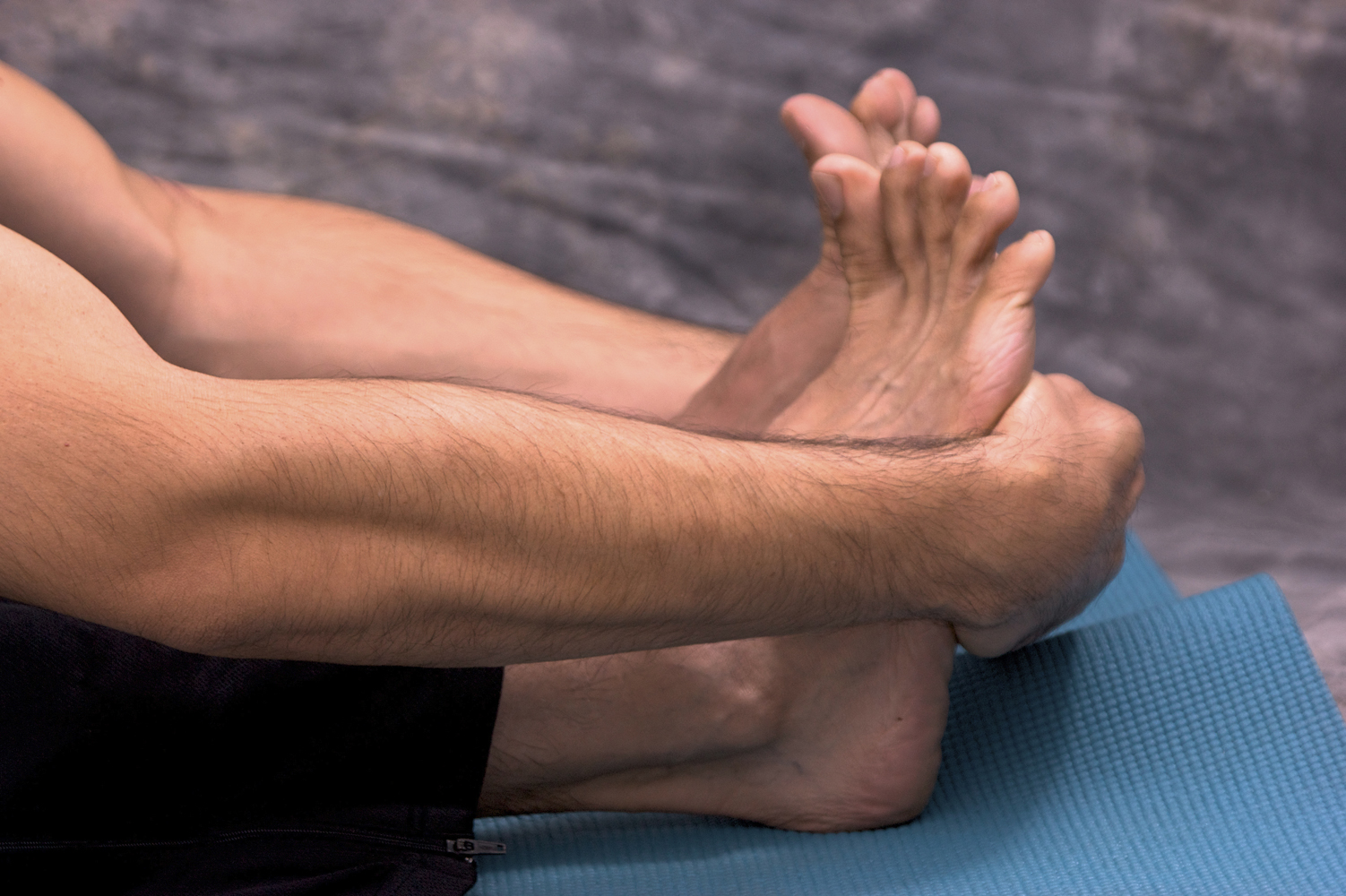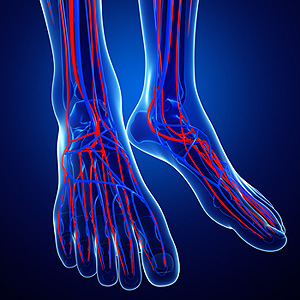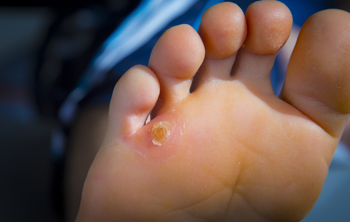Connect With Us
Diabetic Foot Care
Diabetes affects millions of people every year. Blood vessels located all over the body are damaged due to diabetes—even the blood vessels of the feet. Neuropathy, or nerve damage, can result from slower blood flow in the legs and feet. In diabetic patients, neuropathy is very important to monitor, as diabetics are at risk for developing ulcers.
Always washing and thoroughly drying the feet are pertinent parts of diabetic foot care. There should be a focus on cleaning between the toes. Even if no pain is felt, the entire foot should be examined for redness and sores. Neuropathy can often mask the pain of sores and ulcers and can cause these conditions to be overlooked. Use a mirror to examine the underside of your feet if needed. It is recommended that diabetics wear well-fitting socks.
Patients with diabetes should have their doctor monitor their blood levels because blood sugar levels play a huge role in diabetic care. Monitoring these levels on a regular basis is highly advised. It is very important to keep your blood sugar levels in the normal range, which can be determined by your physician. There are medications that may be prescribed to help with any neuropathy experienced by the diabetic patient. It is also advisable to visit a podiatrist if one is experiencing any conditions involving the feet, such as ingrown toenails, which in more severe cases can cause infection.
Diabetic feet must be inspected daily. Diabetic foot care at home is possible if a patient is provided with instructions from their podiatrist. Patients can relieve dry heels with creams or ointments. Suspected wounds should warrant an immediate call to the podiatrist. Gangrene is a serious problem for diabetics and can lead to sepsis and amputation in its worst cases. Early treatment and daily inspection of diabetic feet are keys to staying healthy.
How Effective Are Foot Stretches?
 Stretching the feet can be beneficial in maintaining good foot health. Frequent stretches can make the feet stronger, which helps to maintain balance. Additionally, falling episodes may be limited when the feet are properly stretched. An effective foot stretch can be performed by rolling your foot on a tennis ball for several seconds, followed by repeating on the other foot. The toes can become stronger when toe curls and toe stretches are practiced. This can aid in maintaining good posture while walking. A simple stretch for toe curls can be completed by sitting in a chair and placing a towel under the feet, then scrunch the towel with your toes. A stretch for the Achilles tendon may consist of standing on a step, and gently lowering one heel and a time. If you would like more information about the effectiveness of foot stretches and how to perform them, please consult with a podiatrist.
Stretching the feet can be beneficial in maintaining good foot health. Frequent stretches can make the feet stronger, which helps to maintain balance. Additionally, falling episodes may be limited when the feet are properly stretched. An effective foot stretch can be performed by rolling your foot on a tennis ball for several seconds, followed by repeating on the other foot. The toes can become stronger when toe curls and toe stretches are practiced. This can aid in maintaining good posture while walking. A simple stretch for toe curls can be completed by sitting in a chair and placing a towel under the feet, then scrunch the towel with your toes. A stretch for the Achilles tendon may consist of standing on a step, and gently lowering one heel and a time. If you would like more information about the effectiveness of foot stretches and how to perform them, please consult with a podiatrist.
Stretching the feet is a great way to prevent injuries. If you have any concerns with your feet consult with one of our podiatrists from Podiatry Health Center. Our doctors will assess your condition and provide you with quality foot treatment.
Stretching the Feet
Stretching the muscles in the foot is an important part in any physical activity. Feet that are tight can lead to less flexibility and make you more prone to injury. One of the most common forms of foot pain, plantar fasciitis, can be stretched out to help ease the pain. Stretching can not only ease pain from plantar fasciitis but also prevent it as well. However, it is important to see a podiatrist first if stretching is right for you. Podiatrists can also recommend other ways to stretch your feet. Once you know whether stretching is right for you, here are some excellent stretches you can do.
- Using a foam roller or any cylindrical object (a water bottle or soda can will do), roll the object under your foot back and forth. You should also exert pressure on the object. Be sure to do this to both feet for a minute. Do this exercise three times each.
- Similar to the previous one, take a ball, such as a tennis ball, and roll it under your foot while seated and exert pressure on it.
- Grab a resistance band or towel and take a seat. If you are using a towel, fold it length wise. Next put either one between the ball of your foot and heel and pull with both hands on each side towards you. Hold this for 15 seconds and then switch feet. Do this three times for each foot.
- Finally hold your big toe while crossing one leg over the other. Pull the toe towards you and hold for 15 seconds. Once again do this three times per foot.
It is best to go easy when first stretching your foot and work your way up. If your foot starts hurting, stop exercising and ice and rest the foot. It is advised to then see a podiatrist for help.
If you have any questions, please feel free to contact our office located in Dothan, AL . We offer the newest diagnostic and treatment technologies for all your foot care needs.
Read more about How to Stretch Your FeetHow to Stretch Your Feet
Your feet endure a great amount of stress each day from constantly allowing us to move around. It is important to stretch your feet to help prevent them from becoming injured. Your toes may easily deform into unhealthful positions if they are not stretched.
One of the most common reasons for toe deformities are the shoes you may be wearing. Shoes that are too tight may fold and shift the toes out of place. Heeled shoes may also push your toes upward. Forcing your toes into an unnatural position which may cause the muscles to tighten and prevent them from reverting to normal length. Another common reason is improper use of foot muscles. Many people fail to use the muscles in their feet or toes when they walk. Lastly, the positioning of your feet while walking may also cause toe deformities. If you walk with your feet facing outward, your “push-off” phase is on the side of your big toe instead of the bottom of your foot. This may cause the big toe to eventually tighten into a new shifted position.
There are many reasons why stretching your toes may be helpful. One reason is that healthy spacing may aid in avoiding calluses and other injuries that are caused by rubbing. Stretching will also prevent you from developing toes that curl, hammertoes, or bunions.
A great way to stretch your toes is to place them in your hands and bend them all downward; this will help you stretch the top of your foot. Next, you should repeat this process but instead bend them upward enough to feel a nice stretch in the bottom of your foot. You should then try to pull each toe apart from the next and pull any toes that are bent upward until they are back downward.
If you are looking to practice stretching your entire foot, you can try a towel stretch. This is done by sitting on the floor with your legs in front of you. Take a towel and wrap it around your toes. Afterward, pull the towel toward you with your toes and hold this position for 15 to 30 seconds before releasing. Practice this stretch for three sets. Another stretch your feet are towel lifts. This is done by sitting in a chair and trying to pick a towel up from the ground with your toes. Try lifting the towel with your little toes for five sets before switching feet.
If you are an athlete, or exercise often, it is especially important for you to practice stretching your feet. Those who suffer from foot pain caused by poor footwear, plantar fasciitis, or long hours of standing at work may also benefit from foot exercises.
How Does Morton’s Neuroma Affect the Feet?
 Many people have general aches and pains in their feet. When pain develops in the ball of the foot, it may be indicative of a condition that is referred to as Morton’s neuroma. This is an ailment that affects the nerves in the feet that helps to avoid falling by maintaining balance. It develops as a result of inflamed nerves which can happen for a variety of reasons. These can include wearing shoes that do not fit correctly or from medical ailments consisting of bunions, hammertoe, and flat feet. Mild relief may be found when the affected foot is massaged, and it may be beneficial to wear custom made orthotics. If you have pain in this part of your foot, it is strongly suggested that you seek the counsel of a podiatrist who can properly diagnose and treat Morton’s neuroma.
Many people have general aches and pains in their feet. When pain develops in the ball of the foot, it may be indicative of a condition that is referred to as Morton’s neuroma. This is an ailment that affects the nerves in the feet that helps to avoid falling by maintaining balance. It develops as a result of inflamed nerves which can happen for a variety of reasons. These can include wearing shoes that do not fit correctly or from medical ailments consisting of bunions, hammertoe, and flat feet. Mild relief may be found when the affected foot is massaged, and it may be beneficial to wear custom made orthotics. If you have pain in this part of your foot, it is strongly suggested that you seek the counsel of a podiatrist who can properly diagnose and treat Morton’s neuroma.
Morton’s neuroma is a very uncomfortable condition to live with. If you think you have Morton’s neuroma, contact one of our podiatrists of Podiatry Health Center. Our doctors will attend to all of your foot care needs and answer any of your related questions.
Morton’s Neuroma
Morton's neuroma is a painful foot condition that commonly affects the areas between the second and third or third and fourth toe, although other areas of the foot are also susceptible. Morton’s neuroma is caused by an inflamed nerve in the foot that is being squeezed and aggravated by surrounding bones.
What Increases the Chances of Having Morton’s Neuroma?
- Ill-fitting high heels or shoes that add pressure to the toe or foot
- Jogging, running or any sport that involves constant impact to the foot
- Flat feet, bunions, and any other foot deformities
Morton’s neuroma is a very treatable condition. Orthotics and shoe inserts can often be used to alleviate the pain on the forefront of the feet. In more severe cases, corticosteroids can also be prescribed. In order to figure out the best treatment for your neuroma, it’s recommended to seek the care of a podiatrist who can diagnose your condition and provide different treatment options.
If you have any questions, please feel free to contact our office located in Dothan, AL . We offer the newest diagnostic and treatment technologies for all your foot care needs.
Read more about What is Morton's Neuroma?What is Morton's Neuroma?
Morton’s neuroma, (also referred to as Morton’s metatarsalgia, Morton’s neuralgia, plantar neuroma or intermetatarsal neuroma) is a condition that is caused when the tissue around one of the nerves between your toes begins to thicken. This thickening can result in pain in the ball of the foot. Fortunately, the condition itself is not cancerous.
Morton’s neuroma affects women more often than men with a ratio of 4:1. It tends to target women between the age of 50 and 60, but it can occur in people of all ages. There are some risk factors that may put you at a slightly higher risk of developing the condition. People who often wear narrow or high-heeled shoes are often found to be linked to Morton’s neuroma. Additionally, activities such as running or jogging can put an enormous amount of pressure on the ligament and cause the nerve to thicken.
There usually aren’t any outward symptoms of this condition. A person who has Morton’s neuroma may feel as if they are standing on a pebble in their shoe. They may also feel a tingling or numbness in the toes as well as a burning pain in the ball of their foot that may radiate to their toes.
In order to properly diagnose you, the doctor will press on your foot to feel for a mass or tender spot. He may also do a series of tests such as x-rays, an ultrasound, or an MRI. X-rays are usually done to rule out any other causes for your foot pain such as a stress fracture. Ultrasounds are used to reveal soft tissue abnormalities that may exist, such as neuromas. Your podiatrist may want to use an MRI in order to visualize your soft tissues.
There are three main options for treatment of Morton’s neuroma: Injections, decompression surgery, and removal of the nerve. Injections of steroids into the painful area have been proven to help those with Morton’s neuroma. Decompression surgery has been shown to relieve pressure on the affected nerve by cutting nearby structures such as the ligaments in the foot. Another treatment option would be to surgically remove the growth to provide pain relief.
If you suspect that you have Morton’s neuroma you should make an appointment with your podiatrist right away. You shouldn’t ignore any foot pain that lasts longer than a few days, especially if the pain does not improve.
Foot and Ankle Issues Related to Running
 Foot and ankle health is important to runners, both those who run recreationally and those who run professionally. Runners are susceptible to a variety of overuse injuries, including pain in the heel, pain in the ball of the foot, stress fractures or Achilles tendon problems. Heel pain is most commonly associated with plantar fasciitis, which is the inflammation of the tendon that connects the heel bone to the ball of the foot. Pain in the ball of the foot can indicate a neuroma, a pinched nerve between the toes, or inflammation in the ball of the foot. Achilles tendon pain can indicate Achilles tendonitis, and rest will be necessary. Stress fractures, which occur as tiny breaks in the bones, can lead to swelling and pain, and they will need to be rested as well. If you are a frequent runner and are experiencing pain in the feet or ankles, make sure to consult with a podiatrist for proper diagnosis and treatment.
Foot and ankle health is important to runners, both those who run recreationally and those who run professionally. Runners are susceptible to a variety of overuse injuries, including pain in the heel, pain in the ball of the foot, stress fractures or Achilles tendon problems. Heel pain is most commonly associated with plantar fasciitis, which is the inflammation of the tendon that connects the heel bone to the ball of the foot. Pain in the ball of the foot can indicate a neuroma, a pinched nerve between the toes, or inflammation in the ball of the foot. Achilles tendon pain can indicate Achilles tendonitis, and rest will be necessary. Stress fractures, which occur as tiny breaks in the bones, can lead to swelling and pain, and they will need to be rested as well. If you are a frequent runner and are experiencing pain in the feet or ankles, make sure to consult with a podiatrist for proper diagnosis and treatment.
All runners should take extra precaution when trying to avoid injury. If you have any concerns about your feet, contact one of our podiatrists of Podiatry Health Center. Our doctors will treat your foot care needs.
How to Prevent Running Injuries
There are a lot of mistakes a runner can make prior to a workout that can induce injury. A lot of athletes tend to overstretch before running, instead of saving those workouts for a post-run routine. Deep lunges and hand-to-toe hamstring pulls should be performed after a workout instead of during a warmup. Another common mistake is jumping into an intense routine before your body is physically prepared for it. You should try to ease your way into long-distance running instead of forcing yourself to rush into it.
More Tips for Preventing Injury
- Incorporate Strength Training into Workouts - This will help improve the body’s overall athleticism
- Improve and Maintain Your Flexibility – Stretching everyday will help improve overall performance
- “Warm Up” Before Running and “Cool Down” Afterward – A warm up of 5-10 minutes helps get rid of lactic acid in the muscles and prevents delayed muscle soreness
- Cross-Training is Crucial
- Wear Proper Running Shoes
- Have a Formal Gait Analysis – Poor biomechanics can easily cause injury
If you have any questions, please feel free to contact our office located in Dothan, AL . We offer the newest diagnostic and treatment technologies for all your foot care needs.
Preventing Running Injuries
Over half of all runners encounter at least one injury per year. The reason for this is because many runners do not train properly. Injuries are almost inevitable due to the physical stress that running causes. While our bodies are great at adapting to the stress, it can only handle it in small doses. Injuries occur when the stress is applied too quickly for the body to handle, causing something within it to break down. With each step you take, your leg is absorbing two or three times your body’s weight.
Some of the most popular running injuries are shin splints, plantar fasciitis, Achilles tendinitis, and stress fractures. Shin splints cause pain along the inside or outside of the shins, and this pain is usually felt at the beginning of a run. The condition itself is defined as an inflammation of the muscles or tendons located around the shinbone. To treat shin splints, it is advised that you ice the shin area and stretch the calf muscles. To prevent this injury, you should slowly increase the distance you plan on running, instead of jumping into a more strenuous routine.
Achilles tendinitis is another common injury and it feels like pain along the back of the leg, toward the heel. This condition is defined as an inflammation of the Achilles which is the largest tendon in the body. The Achilles is responsible for connecting your calf muscles to the heel bone and it is caused by tight calf muscles. If you want to treat this injury, you should take a break from running to cross train with a low-impact activity.
There are a lot of common mistakes runners make that are causing them to experience injury. One mistake is stretching too much prior to warming up. If you plan to go on a run, you should warm up with a gentle 3-5-minute walk followed by a 5-minute run-walk. Another common mistake is jumping into a routine too quickly. Consequently, you should incorporate cross-training into your routine. If you are looking to get active, you should slowly weave running into an activity you are currently participating in. For example, you can try bike riding for 40 minutes followed by a 10-minute run.
Another way to prevent running injuries is to choose shoes that are appropriate for running. There are certain things you should look for when buying a new pair of running shoes. An important factor in these sneakers is flexibility. Running shoes should be capable of bending and flexing at the forefoot. However, you should not be able to bend the entire shoe in half with ease because this is a sign that the shoe does not have enough structure. Additionally, you should look for the fit of the running shoes you want to purchase. It is best to visit a specialty running shoe store to have your feet properly sized. Choosing shoes that fit properly can prevent many foot ailments.
If you are suffering from any pain from running injuries, you should make an appointment with your podiatrist to discover the underlying cause of your pain. He or she will be able to help treat your condition in the best way possible.
Treat Yourself and Others With Our Annual December Sale
If you bought an OTC product from us in 2020, you can purchase up to 3 more of the same product at 20% off throughout the month of December.
This sale includes all OTC antifungal topical medications and sprays, lotions or creams, neuropathy pain relief medications, topical wart medications, antifungal nail polish, Powerstep orthotic arch supports or flip flops, Dr. Comfort socks, and many other OTC products used in treating foot and toe pain.
Gift certificates are available year-round!
Why Corns May Develop on the Feet
 People worldwide can be affected by corns on the feet. They are defined as small, hardened portions of skin that have developed as a result of excess friction. Corns can form on the soles of the feet, or between the toes, and can cause severe pain and discomfort. Additional causes of corns can include wearing shoes and socks that do not fit correctly, and medical conditions consisting of bunions and hammertoes. Mild relief may be found when larger shoes are worn if the corn is between the toes. This may help to prevent further irritation that may happen from the toes rubbing together. The corn may soften after the affected foot is soaked in warm water, and it can help to use a pumice stone to eliminate dead skin on top of the corn. If you have corns on your feet, please consult with a podiatrist who can help you to remedy this condition.
People worldwide can be affected by corns on the feet. They are defined as small, hardened portions of skin that have developed as a result of excess friction. Corns can form on the soles of the feet, or between the toes, and can cause severe pain and discomfort. Additional causes of corns can include wearing shoes and socks that do not fit correctly, and medical conditions consisting of bunions and hammertoes. Mild relief may be found when larger shoes are worn if the corn is between the toes. This may help to prevent further irritation that may happen from the toes rubbing together. The corn may soften after the affected foot is soaked in warm water, and it can help to use a pumice stone to eliminate dead skin on top of the corn. If you have corns on your feet, please consult with a podiatrist who can help you to remedy this condition.
If you have any concerns regarding your feet, contact one of our podiatrists of Podiatry Health Center. Our doctors will treat your foot care needs.
Corns: What Are They? and How Do You Get Rid of Them?
Corns can be described as areas of the skin that have thickened to the point of becoming painful or irritating. They are often layers and layers of the skin that have become dry and rough, and are normally smaller than calluses.
Ways to Prevent Corns
There are many ways to get rid of painful corns such as wearing:
- Well-fitting socks
- Comfortable shoes that are not tight around your foot
- Shoes that offer support
Treating Corns
Treatment of corns involves removing the dead skin that has built up in the specific area of the foot. Consult with Our doctors to determine the best treatment option for your case of corns.
If you have any questions please feel free to contact our office located in Dothan, AL . We offer the newest diagnostic and treatment technologies for all your foot care needs.
Read more about Understanding Corns and CallusesUnderstanding Corns and Calluses
Corns and Calluses are both hardened layers of thickened skin that develop because of friction. Both ailments are typically found on the feet and may be unsightly. Although they have similarities, corns and calluses are different from each other.
Some causes of corns and calluses may be wearing ill-fitting shoes and not wearing socks. If you wear tight shoes, your feet will constantly be forced to rub against the shoes, causing friction. If you fail to wear socks, you are also causing your feet to endure excess friction.
There are some signs that may help you determine whether you have one of these two conditions. The first symptom is a thick, rough area of skin. Another common symptom is a hardened, raised bump on the foot. You may also experience tenderness or pain under the skin in addition to flaky, dry, or waxy skin.
There are also risk factors that may make someone more prone to developing corns and calluses. If you are already dealing with bunions or hammertoe, you may be more vulnerable to having corns and calluses as well. Other risk factors are foot deformities such as bone spurs, which can cause constant rubbing inside the shoe.
Corns tend to be smaller than calluses and they usually have a hard center surrounded by inflamed skin. They also tend to develop on the parts of the body that don’t bear as much weight such as the tops and sides of toes. Corns may also be painful for those who have them. On the other hand, calluses are rarely painful. These tend to develop on the bottom of the feet and may vary in size and shape.
Fortunately, most people only need treatment for corns and calluses if they are experiencing discomfort. At home treatments for corns and calluses should be avoided, because they will likely lead to infection. If you have either of these ailments it is advised that you consult with your podiatrist to determine the best treatment option for you.






